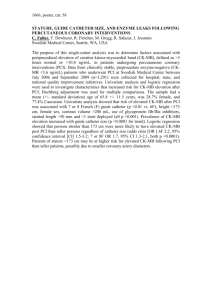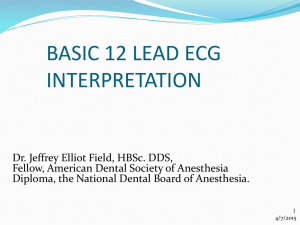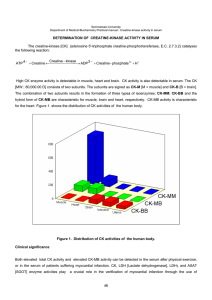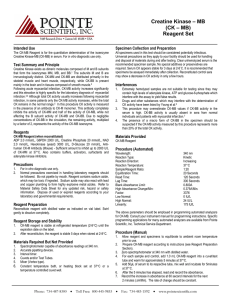Measuring Creatine Kinase MB lsoenzyme in a
advertisement
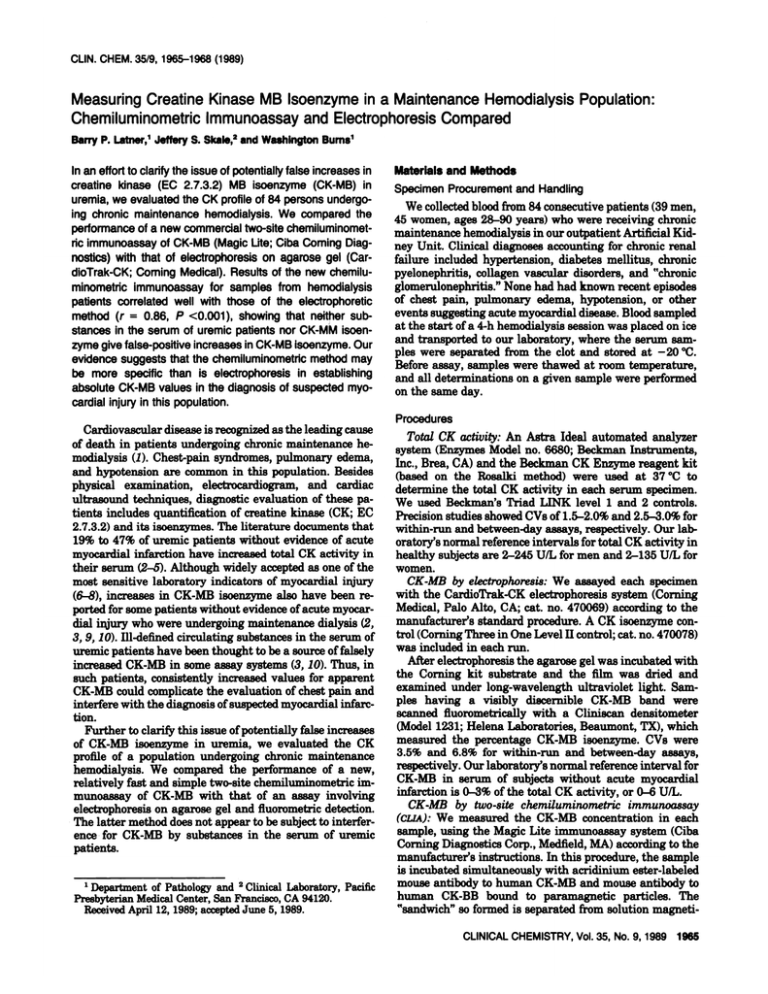
CLIN. CHEM. 35/9, 1965-1968 (1989)
Measuring Creatine Kinase MB lsoenzyme in a Maintenance Hemodialysis Population:
Chemiluminometric Immunoassay and Electrophoresis Compared
Barry P. Latner,1 Jetfery S. Skale,2 and WashIngton Bums’
In an effort to clarify the issue of potentially false increases in
creatine kinase (EC 2.7.3.2) MB isoenzyme
(CK..MB) in
uremia, we evaluated the CK profile of 84 persons undergoing chronic maintenance hemodialysis. We compared the
performance of a new commercial two-site chemiluminometnc immunoassay of OK-MB (Magic Lite; Ciba Coming Diagnostics) with that of electrophoresis on agarose gel (CardioTrak-CK; Coming Medical). Results of the new chemiluminometric immunoassay for samples from hemodialysis
patients correlated well with those of the electrophoretic
method (r = 0.86, P <0.001), showing that neither substances in the serum of uremic patients nor CK-MM isoenzyme give false-positive
increases in CK-MB isoenzyme. Our
evidence suggests that the chemiluminometric method may
be more specific than is electrophoresis in establishing
absolute OK-MB values in the diagnosis of suspected myocardial injury in this population.
Materials and Methods
Specimen Procurement and Handling
We collected blood from 84 consecutive patients (39 men,
45 women, ages 28-90 years) who were receiving chronic
maintenance
hemodialysis in our outpatient Artificial Kidney Unit. Clinical diagnoses accounting for chronic renal
failure included hypertension, diabetes mellitus, chronic
pyelonephritis,
collagen vascular disorders, and “chronic
glomerulonephritis.”
None had had known recent episodes
of chest pain, pulmonary edema, hypotension, or other
events suggesting acute myocardial disease. Blood sampled
at the start of a 4-h hemodialysis session was placed on ice
and transported
to our laboratory, where the serum samples were separated
from the clot and stored at -20 #{176}C.
Before assay, samples were thawed at room temperature,
and all determinations on a given sample were performed
on the same day.
Procedures
Cardiovascular disease is recognized as the leading cause
of death in patients undergoing chronic maintenance hemodialysis (1). Chest-pain syndromes, pulmonary edema,
and hypotension are common in this population. Besides
physical examination,
electrocardiogram,
and cardiac
ultrasound techniques, diagnostic evaluation
of these patients includes quantification
of creatine kinase (CK; EC
2.7.3.2) and its isoenzymes. The literature documents that
19% to 47% of uremic patients without evidence of acute
myocardial
infarction have increased total CK activity in
their serum (2-5). Although widely accepted as one of the
most sensitive laboratory indicators of myocardial injury
(6-8), increases in CK-MB isoenzyme also have been reported for some patients without evidence of acute myocardial injury who were undergoing maintenance dialysis (2,
3, 9, 10). Ill-defined circulating substances in the serum of
uremic patients have been thought to be a source of falsely
increased CK-MB in some assay systems (3, 10). Thus, in
such patients, consistently
increased values for apparent
CK-MB could complicate the evaluation
of chest pain and
interfere with the diagnosis of suspected myocardial infarction.
Further to clarify this issue of potentially false increases
of CK-MB isoenzyme in uremia, we evaluated the CK
profile of a population undergoing
chronic maintenance
hemodialysis.
We compared the performance of a new,
relatively
fast and simple two-site chemiluininometric immunoassay
of CK-MB with that of an assay involving
electrophoresis
on agarose gel and fluorometric detection.
The latter method does not appear to be subject to interference for CK-MB by substances in the serum of uremic
patients.
1 Department
of Pathology and tmClirncal Laboratory, Pacific
Presbyterian Medical Center, San Francisco, CA 94120.
Received April 12, 1989;acceptedJune 5, 1989.
Total CK activity: An Astra Ideal automated analyzer
system (Enzymes Model no. 6680; Beckman Instruments,
Inc., Brea, CA) and the Beckman CK Enzyme reagent kit
(based on the Rosalki method) were used at 37#{176}C
to
determine the total CK activity in each serum specimen.
We used Beckman’s Triad LINK level 1 and 2 controls.
Precision studies showed CVs of 1.5-2.0% and 2.5-3.0% for
within-run and between-day assays, respectively. Our laboratory’s normal reference intervals for total CK activity in
healthy subjects are 2-245 U/L for men and 2-135 UIL for
women.
CK-MB by electrophoresis:
We assayed each specimen
with the CardioTrak-CK
electrophoresis
system (Corning
Medical, Palo Alto, CA; cat. no. 470069) according to the
manufacturer’s standard procedure. A CK isoenzyme control (Corning Three in One Level II control; cat. no. 470078)
was included in each run.
After electrophoresis the agarose gel was incubated with
the Corning kit substrate and the film was dried and
examined under long-wavelength
ultraviolet light. Samples having a visibly discernible CK-MB band were
scanned fluorometrically
with a Cliniscan densitometer
(Model 1231; Helena Laboratories, Beaumont, TX), which
measured the percentage
CK-MB isoenzyme. CVs were
3.5% and 6.8% for within-run
and between-day
assays,
respectively. Our laboratory’s normal reference interval for
CK-MB in serum of subjects without acute myocardial
infarction is 0-3% of the total CK activity, or 0-6 UIL.
CK-MB by two-site chemiluminometric
immunoassay
(CUA):
We measured the CK-MB concentration in each
sample, using the Magic Lite immunoassay system (Ciba
Corning Diagnostics Corp., Medfield, MA) according to the
manufacturer’s instructions.
In this procedure, the sample
is incubated simultaneously with acridinium ester-labeled
mouse antibody to human CK-MB and mouse antibody to
human CK-BB bound to paramagnetic
particles. The
“sandwich” so formed is separated from solution magnetiCLINICAL CHEMISTRY, Vol. 35, No. 9, 1989 1965
200
callyand washed. The resultingproduct isthen placed into
a Magic Lite Analyzer (cat. no. 472733) where analyzer
reagents are injected to activate the acridinium molecules,
resulting in photon output. The amount of CK-MB in the
sample and the magnitude of the chemiluminescence of the
final reaction are directly related, so the Magic Lite Analyzer calculates the CK-MB concentration from the measured photon output. The assay is calibrated to mass units
(i.e., zg/L). Corning Magic Lite level 1 and 2 controls (cat.
no. 472747) were used. Precision studies showed CVs of
1.9-2.5% and 3.9-4.5% for within-run
and between-day
assays, respectively. The normal reference interval for
CK-MB reported by the manufacturer is 0-7.5 tg/L. In our
laboratory, comparison studies with 250 specimens from
150 healthy subjects and patients in the Coronary Care,
Cardiopulmonary,
and Intensive Care Units gave results
that concur with the manufacturer’s reference interval.
The Relative Index of CK-MB, an index directly analogous to the percentage of CK-MB obtained by electrophoresis, is defined as follows:
Relative Index
=
-J
150
LU
z
z
LU
50
C-)
0
0
200
400
600
800
100C
TOTAL CK ACTIVITY (U/L)
Fig. 1. Comparison of total CK activity and creatinine concentration
in sera from chronic maintenance hemodialysis patients
Regressionlineis representedby: creatinine (mg/L) = 0.011 total CK activity
(U/L) + 99.9 (r= 0.24, P<0.11, n = 47)
CK-MB (pg/L)
x 100
total CK(U/L)
The Relative Index is calculated only if total CK activity is
increased. In the above-noted comparison studies, we determined that a Relative Index >3 indicated the myocardium as the source of increased total CK activity.
Creatinine: We analyzed for creatinine in a subset of 47
serum specimens, using an alkaline picrate method and a
Beckman Synchron CX3 clinical system (Model no. 4429)
with Beckman Triad LINK level 1 and 2 controls. CVs were
0-0.5%and 2.5% for within-run and between-day assays,
respectively. Our laboratory’s normal reference interval for
creatinine in healthy subjects is 0-13 mg/L.
100
25
20
(I)
15
0
I
0
10
0
I-
0
5
w
LU
0
0
5
10
15
20
25
CHEMILUMINOMETRIC IMMUNOASSAY
CK-MB (g/L)
Fig. 2. CK-MB method comparison, CLIA vs electrophoresis
Results
Total CK activity: The range for total CK activity in the
84 serum specimens was 20-789 UIL, with a mean of 175
U/L (Table 1). Of these values, 21% exceeded the reference
interval.
The values for total CK activity and creatinine were
compared by the Pearson product moment correlation test,
but showed no relationship (r = 0.24, P <0.11, n = 47).
Figure 1 shows a graphic representation and standard
linear-regression analysis.
CK-MB by EP and CLIA: No atypical migrating CK
bands or CK-BB isoenzyme were identified by electrophoresis in our study samples. There was a strong correlation
(Figure 2) between the CK-MB values obtained by electrophoresis and CLIA as demonstrated by the Pearson product
moment correlation test (r = 0.86, P <0.001, n = 84).
The values for CK-MB concentration as measured by
Regression line is represented by: CK-MB by electrophoresis
(U/L)= 1.25
CK-MB by CLIA (zg/L) - 2.19 (r = 0.86, P <0.001, n = 84)
CLIA were compared
with creatinine concentrations, but
showed no relationship (r = 0.24, P <0.11, n = 47). The
regression line is represented by the equation: creatinine
(mgfL) = 0.34CK-MB (mgfL) + 103.6.
Table 1 demonstrates that 11% (9 of 84) of the absolute
CK-MB values obtained by electrophoresis and 6% (5 of 24)
by CLL fell outside our reference intervals. Table 2 lists
complete CK profiles for these specimens. Laboratory criteria suggesting acute myocardial
injury were fulifiled in
only two patients (A23 and A63), who were identified by
both methods.
The first patient (A63), an 84-year-old man with chronic
atrial fibrillation
and a remotely documented myocardial
Table 1. Results of DetermInatIons
No. (and%) of dialysli
patients with Increased
DialysIs
patients
Creatinine, mg/L
TotalCK, U/L
Ref. Interval
0-13
Men: 2-245
49-189
CK-MB by electrophoresis,U/L
CK-M8 by CLIA, p.g/L
Women:2-135
0-6
0-7.5
21-789
0-27
0.8-20.7
1966 CLINICAL CHEMISTRY, Vol. 35, No. 9, 1989
Range
20-542
Mean
117
120
139
2.7
3.9
values
47 of 47 (100)
4 of 39 (10)
14 of 45 (31)
9 of 84 (11)
5 of 84 (6)
Table 2. CK Profiles of SpecImens wIth Increased
Absolute CK-MB by Electrophoresls or CLIA
CK-MB by
eiectr.
Patient
Total
CK, U/L
A6
A23
A28
542
A33
789
A38
A49
A63
A67
A79
343
408
200
243
557
CK-MB by cuA
%
U/L
pg/L
1.4
3.8
1.8
1.8
2.5
2.3
12.9
8
9
10
14
9
9
11.5
12.2
27
20.7
9.1
9.1
6.5
4.4
RelatIve
lndex
2.1
5.0
1.6
1.2
1.9
11
_a
1.3
1.6
8
6.8
12
6.6
2.4
13
Calculated only if total CK activityis increased.Patient
A63 is a man.
510
490
infarction, developed chest pain 1 to 2 h after the start of
hemodialysis on the date blood was drawn for this study.
Serial electrocardiograms and CK proffles demonstrated
acute myocardial infarction. The second patient (A23) was
a 70-year-old woman with orthopnea and chronic dyspnea
on exertion. Numerous chest roentgenograms
documented
cardiomegaly and mild vascular congestion, but she had
had no documented myocardial
infarctions. She was without complaints on the date blood was drawn for this study.
Subsequently,
she developed two episodes of hemodialysis
forearm-graft occlusion, necessitating surgical revision. In
the postoperative
period of the latter surgery, she became
asystolic. Permission for necropsy was not granted.
The sensitivity,
specificity,
and positive and negative
predictive values (all in percent) for absolute CK-MB by
electrophoresis and CLIA for acute myocardial injury were
100, 91, 22, 100, and 100, 96, 40, and 100, respectively.
However, all of these statistical calculations are 100% for
both methods when properly interpreted in conjunction
with total CK activity.
activities of CK-MB that are not related to myocardial
infarction. In such patients there is usually an increased
total CK activity, attributable to damage of tissues other
than the heart (e.g., skeletal muscle). The ratio of CK-MB
to total CK in other tissues is lower than that for the heart
(19). Laboratory criteria that suggest acute myocardial
injury include an increased absolute amount of CK-MB
when total CK activity is within the reference interval or
an increased relative amount of CK-MB in conjunction
with an increased total CK activity.
In evaluating the new two-site chemiluminometric immunoassay for CK-MB in this study, we found excellent
correlation with our electrophoretic
method (r = 0.86,
P <0.001). Both techniques showed 82 of 84 patients to
have CK-MB values lower than would suggest myocardial
injury. Of the remaining two patients, one had a documented acute myocardial
infarction and the other had a
clinical course suggesting myocardial injury. Furthermore,
CK-MB concentration showed no correlation to predialysis
creatimne values (r = 0.24, P <0.11). Thus, our results
demonstrate that uremia alone does not result in significant increases of CK-MB values by either method, and
imply that measurement of CK-MB remains a good diagnostic test in the workup of chest pain syndromes in this
population. Electrophoresis shows less discrimination of
CK-MB activities at the lower end of the scale than does
CLIA (Figure 2), reflecting the relative insensitivity inherent in the quantitative application of electrophoresis. This
is a theoretical advantage of CLIA, an advantage reflected in
our limited data by the selection of only five of 84 patients
with increased CK-MB concentration by CLIA compared
with nine patients by electrophoresis.
Our study validates the use of the new chemiluminometnc immunoassay
in hemodialysis patients and shows that
neither substances in the serum of uremic patients nor
CK-MM isoenzyme interfere with the determination of
CK-MB isoenzyme. This assay, with use of established
reference intervals and serial determinations of total CK
activity and CK-MB, can be used with confidence in the
laboratory evaluation of acute myocardial injury.
Discussion
Our data show that 21% of the specimens from patients
undergoing
chronic maintenance hemodialysis had increased CK activities, a finding consistent with that of
others (2-5). Such values are independent of pre-dialysis
creatinine concentrations, as noted in Figure 1 (r = 0.24,
P <0.11). The primary source of CK appears to be skeletal
muscle, as reflected by the predominance of CK-MM isoenzyme activity in the electrophoretogram, which is in keeping with previously proposed concepts of “uremic myopathy” (4, 11, 12).
We found CK-BB isoenzyme in none of our specimens by
electrophoresis, contrary to the findings of others (5, 13,
14). Other studies also have shown that CK-BB is not
increased in patients with renal failure; rather, some
substance in the serum produces fluorescent interference in
the determination of CK-BB by some electrophoretic
methods involving fluorescent densitometry (2,3, 15,16). Interference was not observed by Homburger
et al. (17) or
Pascual et al. (18), who used immunological methods to
measure CK-BB in hemodialysis patients (17, 18).
In the laboratory evaluation of patients suspected of
having acute myocardial
injury it is important to quantify
both the absolute and relative amounts of CK-MB (7). It is
well known that some patients’ serum contains increased
We are especially grateful to the following individuals (Pacific
Presbyterian Medical Center) for their valuable assistance: Voula
Sideris and Gloria Rashti (Clinical Laboratory), Dr. Gary Truex
and the entire nursing staff of the Artificial Kidney Unit, Dr.
David Farrar (Medical Research Institute), and David Leaffer and
Deborah Cabebe (Department of Pathology).
References
1. Lindner A, Charra B, Sherrard DJ, Scribner BH. Accelerated
atherosclerosis
in prolongedmaintenance hemodialysis.N EngI J
Med 1974;290:697-701.
2. Cohen IM, Griffiths J, Stone BA, Leech T. The creatine kinase
profile of a maintenance hemodialysis population: a possible
marker of uremic myopathy. Clin Nephrol 1980;13:235-8.
3. Jaffe AS, Ritter C, Meltzer V, Harter H, Roberts R. Unmasking
artifactual increases in creatine kinase isoenzymes in patients
with renal failure. J Lab Clin Med 1984;104:193-202.
4. Soffer 0, Fellner SK, Rush RL. Creatine phosphokinase in
long-term dialysis patients. Arch Intern Med 1981;141:181-3.
5. Galen RS. Creatine kinase isoenzyme BB in serum of renaldisease patients [Letter]. Clin Chem 1976;22:120.
6. Galen RS, Gambino R. Isoenzymes of CPK and LDH in myocardial infarction and certain other diseases [Review]. Pathobiol
Annu 1985;5:283-315.
7. Lott JA, Stang JM. Serum enzymes and isoenzymes in the
diagnosis of myocardial ischemia and necrosis [Review]. Clin
Chem 1980;260:1241-50.
8. Galen RS. Isoenzymes and myocardial infarction. Diagn Med
CLINICAL CHEMISTRY, Vol. 35, No. 9, 1989 1967
1978;1:40-52.
9. Martinez-Vea A, Montoliu J, Company X, Vives A, LopezPedret J, Revert L. Elevated CK-MB with normal total creatine
kinase levels in patients undergoing maintenance hemodialysis
[Letter]. Arch Intern Med 1982;142:2346.
10. Medeiros IA, Gerson B. Creatine kinase MB isoenzyme in
serum of uremic patients: electrophoresis and quantification with
the Corning models 720 and 706 fluorometer/densitometer [Letter]. Clin Chem 1986;32:227-8.
11. Floyd M, Ayyar DR, Barwick DD, Hudgson P, Weightman D.
Myopathy in chronic renal failure. Q J Med 1974;43:509-24.
12. Goodhue WW, David JN, Porn RS. Ischemic myopathy in
uremic hyperparathyroidism.
J Am Med Assoc 1972;221:911-2.
13. Weseley SA, Byrnes A, Alter S, Solangi KB, Goodman Al.
Presence of creatine phosphokinase brain band in the serum of
chronic renal disease patients. Clin Nephrol 1977;8:345-8.
14. Byrnes AC, Alter S. Important to separate creatine kinase
isoenzyme BB [Letter]? Clin Chem 1975;21:1845.
15. CoolenRB, Herbstman R, Hermann P. Spurious brain creatme kinase in serum from patients with renal disease. Clin Chem
1978;24:1636-8.
16. Aleyassine H, Tonks DB, Kaye M. Natural fluorescence in
serum ofpatientswith chronic renal failure not to be confused with
creatine kinase-BB isoenzyme. Clin Chem 1978;24:492-4.
17. Homburger HA, Miller SA, Jacob GL. Radioiinmunoaaaay
creatine kinase B isoenzymeson serum of patients with azotemia,
obstructive uropathy, or carcinoma of the prostateor bladder.Clin
Chem 1980;26:1821-4.
18. Pascual C, Segura RM, Schwartz S. Situations that can leadto
increased creatine kinase isoenzyme BB activity in serum [Letter].
Clin Chem 1978;24:729-30.
19. Trung SW. Creatine kinase isoenzyme patterns in human
tissue
obtained at surgery. Clin Chem 1976;22:173-5.
CLIN. CHEM. 35/9, 1968-1970 (1989)
Lactate Dehydrogenase and Its Isoenzymes in Serum from Patients with Multiple Myeloma
SItkIcopur,1’4Sezal Ku.,3 Ayse Kars,2 Nurten Renda,3 G#{252}Iten
Tekuzman,2 and Dlncer FIrat2
Concentrations of total lactate dehydrogenase (LDH; EC
1.1.1.27)
and LDH isoenzyme patterns were studied in
serum of 19 patients with multiple myeloma and in 19 healthy
controls. Patients were divided into three groups (pretreatment, nonresponders, and responders to treatment), based
on their clinical status at the time of blood sampling for LDH.
The LDH values were found to be significantly higher
(P <0.05) in the pretreatment group and in the nonresponders than in the responders
and the control group, the
mean ± SE values being 445 ± 35 and 532 ± 75 units/mL vs
349 ± 75 and 190 ± 7.1 units/mL, respectively. Compared
with responders and healthy controls, newly diagnosed patients and nonresponders had slightdiminutions in LDH-1
and LDH-2, but increased LDH-3. We conclude that determination of LDH and its isoenzymes in serum can be of value
as prognostic factors in patients with multiple myeloma.
Lactate dehydrogenase (LDH; EC 1.1.1.27), a glycolytic
enzyme, is present in various tissues and neoplasms of the
human body in multiple molecular forms. This heterogeneity allows electrophoretic fractionation of the enzyme into
at least five isoenzymes (1,2). In recent years the relationship between neoplasia and LDH has been studied with
increasing intensity
(3,4). Serum LDH is known to be of
prognostic significance
in hematological
malignancies such
as leukemia and malignant lymphoma (5-7). Moreover,
in
some patients with malignancy,
changes in specific LDH
isoenzyme patterns in serum correlate with tumor growth
or regression; such changes have been used as tumor
markers
for monitoring therapy or detecting recurrent
Departments of 1 Internal Medicine, 2Oncology,
and
3Biochemistry, Hacettepe University, Faculty of Medicine, Ankara, Turkey.
‘Address for correspondence: Bestekar Sokak 76/10, Kayaklidere-Ankara, Turkey.
Received March 6, 1989; accepted June 6, 1989.
1968 CLINICAL CHEMISTRY, Vol. 35, No. 9, 1989
disease (8,9). Although the prognostic value of serum LDH
in multiple myeloma has been reported (10), LDH isoen-
zyme patterns have been studied in very few patients with
this disorder (11). Thus the distribution of LDH isoenzymes
and their possible significance
in prognosis of multiple
myeloma patients have not yet been established. We undertook this study to determine the value of determining
LDH activity and the isoenzyme pattern in serum of
patients with multiple myeloma.
PatIents and Methods
Serum LDH and its isoenzymes
were studied in 19
patients with multiple myeloma: nine men, 10 women,
ages 52 ± 3 years (mean ± SE; range 43-73). At the time
of serum sampling, 10 patients were newly diagnosed and
had received no treatment
(pretreatment group). Of the
nine patients who had been given treatment,
five had
responded to therapy (responders), and four had not (nonresponders). Patients with concomitant malignancies were
excluded from the study. Venous blood samples obtained
from 19 healthy normal people (11 men, eight women, ages
49 ± 3 years; range 28-75) served as controls. Blood
samples, allowed to clot for 30 mm at room temperature,
were centrifuged
to separate the serum, and total LDH
activity and LDH isoenzyme concentrations were determined that same day. Serum samples with any signs of
hemolysis were discarded.
Diagnosis and classification of the patients: The diagnosis
of multiple myeloma was based on the fulfillment
of at least
two of the three following criteria: demonstration of focal or
generalized increase in abnormal plasma cells in the bone
marrow
or other tissues; presence of serum or urinary
myeloma proteins, often with an associated reduction of
irnmunoglobulin
concentration;
and typical roentgenographic changes.
Of the 19 patients with multiple myeloma, 18 had IgG
and one had IgA myeloma. The patients were staged
according to the method of Dune and Salmon (12): three
